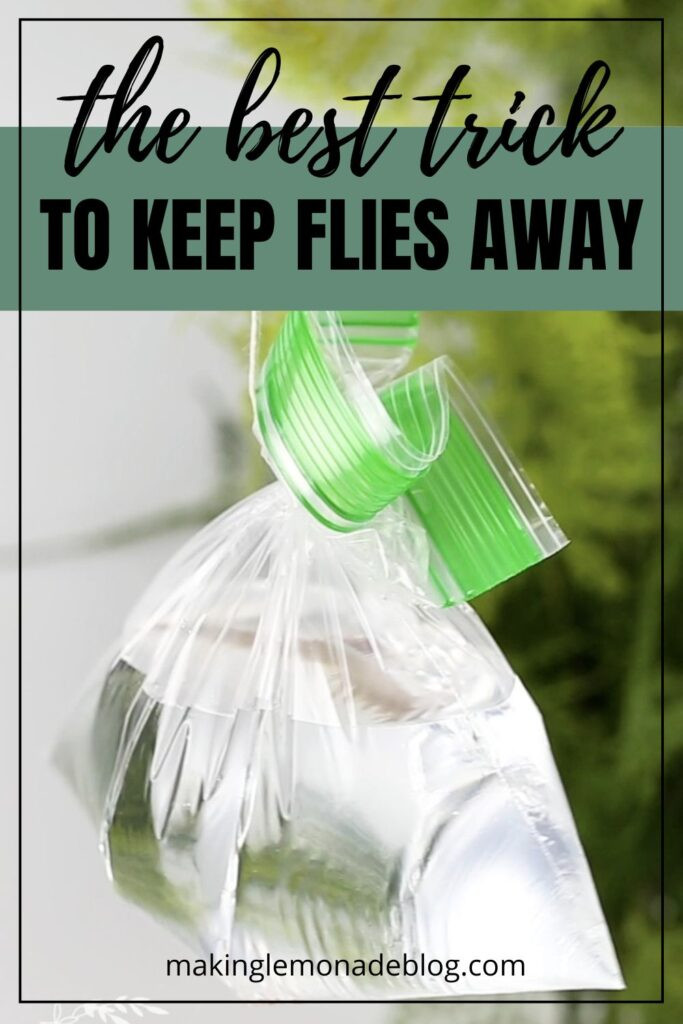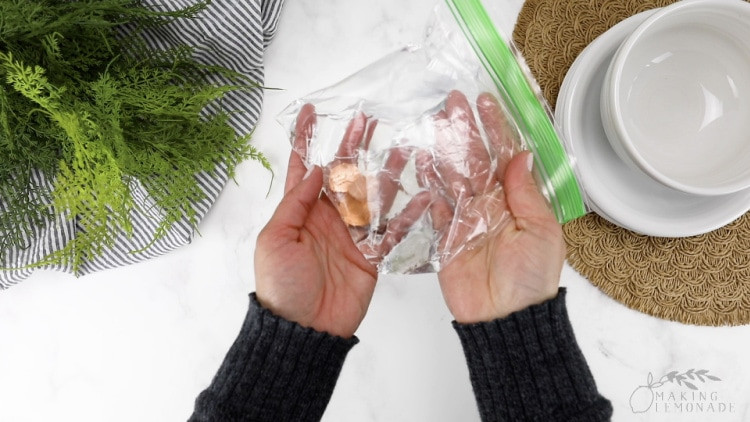Getting rid of flies outside can be a challenge, but what if you could do it with items you already have at home? At flyermedia.net, we explore simple, effective, and homemade solutions to keep those pesky flies away, allowing you to enjoy your outdoor spaces in peace. These DIY methods are not only cost-effective but also environmentally friendly, offering a natural way to manage flies around your home. Discover natural fly control, outdoor pest control, and effective fly traps to reclaim your backyard.
1. Understanding the Fly Problem
Before diving into solutions, it’s important to understand why flies are attracted to your outdoor spaces. Understanding these attractants can help you implement more effective prevention and control strategies.
1.1. What Attracts Flies Outdoors?
Flies are primarily attracted to decaying organic matter, which serves as both a food source and a breeding ground. This includes:
- Garbage: Open or poorly sealed garbage cans are a major attractant. Flies are drawn to the smell of rotting food and waste.
- Pet Waste: Animal feces, especially dog and cat waste, are breeding sites for flies.
- Compost Piles: While compost can be beneficial for gardening, an improperly managed compost pile can attract flies due to the decomposing organic material.
- Food Spills: Residue from outdoor cooking, spilled drinks, and uneaten food left on patios or decks can quickly draw flies.
- Standing Water: Stagnant water provides a breeding ground for many types of flies, including mosquitoes.
1.2. Types of Flies You Might Encounter
Different types of flies may be present in your outdoor areas, each with its own habits and preferences:
- House Flies: These are the most common type of fly found around homes. They are attracted to garbage, decaying food, and animal waste.
- Blow Flies: Often larger and metallic in color, blow flies are attracted to decaying meat and carrion. They are commonly found near garbage cans and areas where animals may have died.
- Fruit Flies: These small flies are attracted to overripe fruits, vegetables, and fermented liquids. They are commonly found in gardens and near fruit trees.
- Drain Flies: Also known as moth flies, these small, fuzzy flies breed in drains and sewers. They can become a nuisance near outdoor plumbing fixtures.
 House Flies
House Flies
2. Homemade Fly Repellents
Creating your own fly repellents is a great way to manage fly populations without relying on harsh chemicals. These remedies are simple, cost-effective, and utilize ingredients you likely already have in your home.
2.1. The Penny Trick
One of the simplest and most intriguing methods for repelling flies is the penny trick. This involves using pennies in water to create a visual deterrent that flies avoid.
- How It Works: Fill clear glasses or plastic bags with water and add a few pennies. Place these around your outdoor eating areas or hang them from trees or patio covers.
- Why It Works: The theory is that the reflection of light off the water and pennies creates a shimmering effect that disorients flies. Some believe the pennies resemble the compound eyes of a larger insect, scaring the flies away.
- Effectiveness: While anecdotal evidence suggests this method can be effective, results may vary. It’s worth trying, especially since it requires minimal effort and resources.
2.2. Essential Oil Sprays
Essential oils are a natural and pleasant-smelling way to repel flies. Many essential oils have insect-repelling properties and can be combined to create effective sprays.
- Popular Essential Oils for Fly Repellents:
- Lavender: Known for its calming scent, lavender is also a powerful insect repellent.
- Peppermint: Peppermint oil has a strong, refreshing scent that flies dislike.
- Eucalyptus: With its medicinal aroma, eucalyptus oil is effective at repelling a variety of insects, including flies.
- Citronella: A common ingredient in commercial insect repellents, citronella is highly effective against flies and mosquitoes.
- Clove: Clove oil has a strong, spicy scent that deters flies.
- DIY Essential Oil Spray Recipe:
- Combine 10-15 drops of your chosen essential oil(s) with 1 cup of water in a spray bottle.
- Add 1 tablespoon of witch hazel or rubbing alcohol to help emulsify the oil and water.
- Shake well before each use.
- Spray around outdoor areas, such as patios, decks, and picnic tables.
- Reapply every few hours or as needed.
2.3. Vinegar Traps
Vinegar is another household item that can be used to trap and kill flies. Flies are attracted to the scent of vinegar, especially apple cider vinegar.
-
Apple Cider Vinegar Trap:
- Pour about 1/2 cup of apple cider vinegar into a jar or bowl.
- Add a few drops of dish soap to break the surface tension of the vinegar.
- Cover the jar or bowl with plastic wrap and secure it with a rubber band.
- Poke small holes in the plastic wrap to allow flies to enter.
- Place the trap in areas where flies are common.
- Flies will be attracted to the vinegar, enter the trap, and drown in the soapy solution.
-
Balsamic Vinegar Spray:
- Fill a spray bottle with balsamic vinegar.
- Spray directly onto flies or in areas where they congregate.
- The strong scent of balsamic vinegar will repel flies.
2.4. Sugar and Milk Trap
This method combines sugar and milk to create a sweet bait that attracts flies. Adding pepper helps to kill the flies once they are drawn to the mixture.
- How to Make a Sugar and Milk Trap:
- Mix 1/4 cup of milk, 1/2 cup of sugar, and 2 tablespoons of ground black pepper in a shallow dish.
- Place the dish in an area where flies are prevalent.
- Flies will be attracted to the sweet mixture, and the pepper will help to kill them.
2.5. Herb Sachets and Plantings
Certain herbs have natural fly-repelling properties. Placing sachets of dried herbs around your outdoor areas or planting these herbs in your garden can help to keep flies away.
- Effective Herbs for Repelling Flies:
- Basil: Basil has a strong scent that flies dislike. Place basil plants near doorways and windows or use dried basil in sachets.
- Lavender: In addition to its pleasant scent, lavender is an effective fly repellent. Plant lavender in your garden or use dried lavender in sachets.
- Mint: Mint, especially peppermint, is a natural insect repellent. Plant mint around your patio or use mint sprigs in vases.
- Rosemary: Rosemary has a strong, woody scent that flies avoid. Plant rosemary in your garden or use dried rosemary in sachets.
- Bay Leaves: Bay leaves have a pungent scent that repels flies. Place bay leaves in areas where flies are common, such as near garbage cans and outdoor eating areas.
3. Prevention Strategies
In addition to using homemade repellents, implementing preventive measures is essential for controlling fly populations. By eliminating attractants and maintaining a clean outdoor environment, you can significantly reduce the number of flies around your home.
3.1. Maintain Cleanliness
Keeping your outdoor areas clean is the first step in preventing fly infestations. Regularly cleaning up spills, removing garbage, and managing pet waste can eliminate many of the attractants that draw flies to your property.
- Garbage Management:
- Use garbage cans with tight-fitting lids.
- Regularly clean and disinfect garbage cans to remove food residue and odors.
- Dispose of garbage frequently to prevent buildup.
- Pet Waste Removal:
- Clean up pet waste daily.
- Dispose of pet waste in sealed bags in the garbage.
- Consider using a pet waste disposal system.
- Outdoor Cooking Areas:
- Clean up food spills and crumbs immediately.
- Wipe down outdoor tables and countertops after meals.
- Cover food when eating outdoors to prevent flies from landing on it.
- Compost Management:
- Turn compost piles regularly to promote decomposition and reduce odors.
- Cover compost piles to prevent flies from accessing the organic material.
- Avoid composting meat, dairy, and oily foods, as these can attract flies.
3.2. Eliminate Standing Water
Flies, including mosquitoes, breed in standing water. Eliminating sources of standing water around your property can significantly reduce fly populations.
- Common Sources of Standing Water:
- Flower Pots: Empty saucers under flower pots to prevent water from collecting.
- Gutters: Clean gutters regularly to ensure proper drainage.
- Bird Baths: Change the water in bird baths frequently.
- Tires: Dispose of old tires properly, as they can collect water.
- Buckets and Containers: Store buckets and containers upside down to prevent water from accumulating.
- Tips for Eliminating Standing Water:
- Fill in low-lying areas in your yard that collect water.
- Ensure proper drainage around your property.
- Use mosquito dunks in ponds or water features to kill mosquito larvae.
3.3. Use Fly Traps
Commercial fly traps can be an effective way to reduce fly populations, especially in areas where flies are particularly problematic.
- Types of Fly Traps:
- Fly Paper: Sticky fly paper attracts and traps flies. Hang fly paper in areas where flies are common.
- Fly Bags: These traps contain a bait that attracts flies. Flies enter the bag and drown in the liquid.
- Electric Fly Traps: These traps use ultraviolet light to attract flies and then electrocute them.
- Placement of Fly Traps:
- Place fly traps in areas where flies are most active, such as near garbage cans, outdoor eating areas, and gardens.
- Keep fly traps away from areas where children and pets may come into contact with them.
- Replace fly traps regularly to maintain their effectiveness.
 Pennies in a bag of water
Pennies in a bag of water
3.4. Screen Doors and Windows
Ensuring that your doors and windows are properly screened can prevent flies from entering your home. Repair or replace damaged screens to create a barrier against flies.
- Tips for Using Screens:
- Keep doors and windows closed when possible.
- Check screens regularly for holes and tears.
- Repair or replace damaged screens promptly.
- Use screen doors on all exterior doors.
3.5. Professional Pest Control
If you are struggling to control fly populations on your own, consider hiring a professional pest control service. Pest control professionals have the expertise and tools to effectively manage fly infestations.
- Benefits of Professional Pest Control:
- Accurate identification of fly species.
- Targeted treatments to eliminate fly breeding sites.
- Preventive measures to reduce future infestations.
- Safe and effective use of insecticides.
4. Innovative Fly Control Methods
In addition to traditional methods, several innovative approaches can help you control flies in your outdoor spaces.
4.1. Biological Control
Biological control involves using natural predators and parasites to control fly populations. This method is environmentally friendly and can be highly effective.
- Fly Predators:
- Fly parasites, such as parasitic wasps, lay their eggs inside fly pupae, killing the developing flies.
- These parasites can be purchased and released in areas where flies are common.
- Nematodes:
- Beneficial nematodes are microscopic worms that attack and kill fly larvae in the soil.
- Apply nematodes to compost piles, gardens, and other areas where flies breed.
4.2. Repellent Plants
Planting certain types of plants around your outdoor areas can help to repel flies and other insects.
- Effective Repellent Plants:
- Marigolds: Marigolds have a strong scent that repels flies and other insects. Plant marigolds around your patio or garden.
- Nasturtiums: Nasturtiums are edible flowers that repel a variety of pests, including flies. Plant nasturtiums in your garden or containers.
- Petunias: Petunias have a sticky residue that traps small insects, including flies. Plant petunias around your outdoor areas.
4.3. UV Light Traps
UV light traps attract flies using ultraviolet light and then capture or electrocute them. These traps are effective for controlling fly populations in enclosed outdoor areas, such as patios and porches.
- How UV Light Traps Work:
- UV light attracts flies to the trap.
- Flies are either electrocuted by an electric grid or trapped on a sticky surface.
- The trap should be placed in an area where flies are common but away from human activity.
- Benefits of UV Light Traps:
- Effective at attracting and killing flies.
- Safe for use around humans and pets.
- Easy to maintain and clean.
5. Addressing Common Myths About Fly Control
There are several common myths about fly control that can lead to ineffective strategies. Understanding these myths can help you make informed decisions about how to manage flies in your outdoor spaces.
5.1. Myth: Flies Are Only a Problem in Dirty Areas
While flies are attracted to filth, they can also be found in clean environments. Flies are opportunistic and will seek out any source of food or breeding material, regardless of how clean an area may appear.
- Reality: Flies can be attracted to even small amounts of food residue or standing water. Maintaining a clean environment is important, but it is not always enough to prevent fly infestations.
5.2. Myth: One Fly Is Not a Big Deal
Even a single fly can be a nuisance and a potential health hazard. Flies can carry diseases and contaminate food.
- Reality: Flies can reproduce quickly, so a small fly problem can quickly become a large infestation. It is important to address fly problems promptly, even if there are only a few flies present.
5.3. Myth: All Insecticides Are Safe for Fly Control
Many insecticides can be harmful to humans, pets, and the environment. It is important to use insecticides safely and responsibly.
- Reality: Choose insecticides that are specifically designed for fly control and follow the label instructions carefully. Consider using natural or organic insecticides whenever possible.
5.4. Myth: Fly Traps Will Eliminate All Flies
While fly traps can be effective at reducing fly populations, they are not a complete solution. Fly traps only capture flies that are attracted to the bait or light.
- Reality: Fly traps should be used as part of a comprehensive fly control strategy that includes preventive measures and sanitation practices.
6. Frequently Asked Questions About Fly Control
Here are some frequently asked questions about controlling flies in outdoor environments.
6.1. What are the best ways to prevent flies from breeding in my yard?
Preventing flies from breeding in your yard involves eliminating breeding sites, such as standing water, garbage, and pet waste. Regularly cleaning up these attractants can significantly reduce fly populations.
6.2. How can I keep flies away from my outdoor dining area?
To keep flies away from your outdoor dining area, use a combination of repellents, traps, and preventive measures. Essential oil sprays, vinegar traps, and the penny trick can all be effective. Additionally, keep the area clean and cover food when possible.
6.3. Are there any natural predators of flies that I can attract to my yard?
Yes, attracting natural predators of flies, such as birds and parasitic wasps, can help control fly populations. Provide bird feeders and bird baths to attract birds, and release parasitic wasps in areas where flies are common.
6.4. What essential oils are most effective for repelling flies?
Lavender, peppermint, eucalyptus, citronella, and clove essential oils are all effective for repelling flies. Use these oils in sprays, diffusers, or sachets to keep flies away from your outdoor areas.
6.5. How often should I clean my garbage cans to prevent flies?
Garbage cans should be cleaned and disinfected regularly, at least once a month, to prevent flies from breeding. More frequent cleaning may be necessary during warm weather or if the cans become particularly dirty.
6.6. Can I use fly traps indoors and outdoors?
Yes, fly traps can be used both indoors and outdoors. However, it is important to choose the right type of trap for each location. Outdoor fly traps should be placed away from human activity, while indoor traps should be placed in areas where flies are common but out of reach of children and pets.
6.7. What are the signs of a severe fly infestation?
Signs of a severe fly infestation include large numbers of flies buzzing around your property, the presence of fly larvae (maggots), and a foul odor. If you notice these signs, it is important to take action to control the infestation promptly.
6.8. How can I get rid of flies in my compost pile?
To get rid of flies in your compost pile, turn the pile regularly, cover it with a layer of soil or leaves, and avoid composting meat, dairy, and oily foods. You can also use beneficial nematodes to kill fly larvae in the compost pile.
6.9. Are there any plants that attract flies that I should avoid planting in my yard?
Certain plants, such as those with decaying or fermenting fruit, can attract flies. Avoid planting these types of plants near your outdoor living areas.
6.10. When should I consider hiring a professional pest control service for fly control?
Consider hiring a professional pest control service if you are unable to control fly populations on your own, if you have a severe fly infestation, or if you are concerned about the health risks associated with flies.
7. Conclusion
Controlling flies in your outdoor spaces is essential for creating a comfortable and healthy environment. By understanding what attracts flies, implementing preventive measures, and using homemade repellents and traps, you can effectively manage fly populations without relying on harsh chemicals. Explore flyermedia.net for more tips and solutions to keep your outdoor areas fly-free.
Ready to reclaim your backyard and enjoy outdoor living without the annoyance of flies? Visit flyermedia.net today to discover more effective strategies, detailed guides, and the latest innovations in pest control. Don’t let flies ruin your outdoor experiences—take control and create a fly-free zone around your home.
